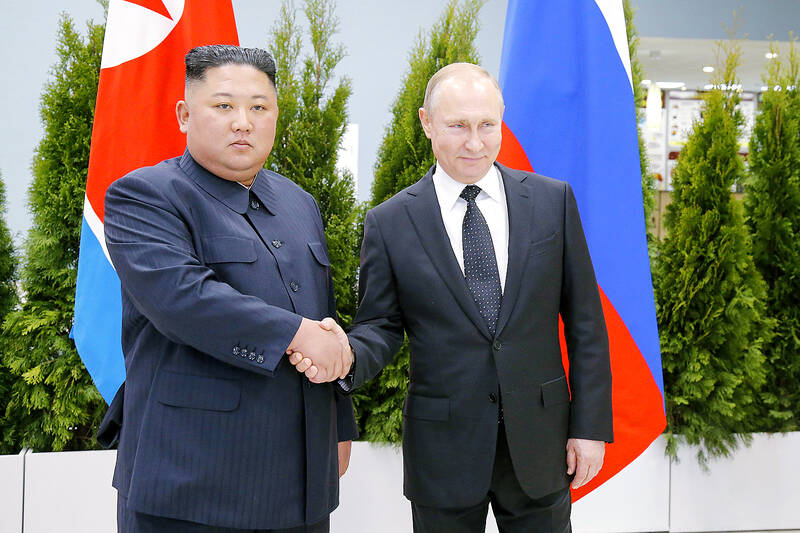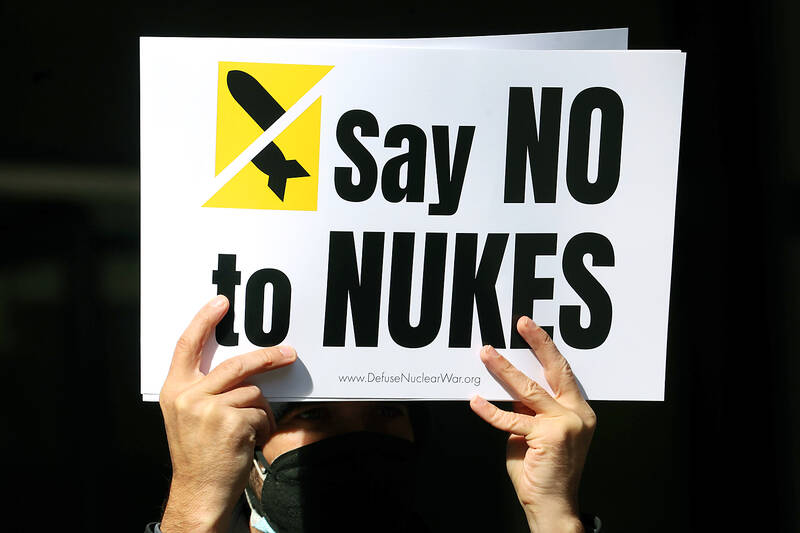From the war in Ukraine to North Korea’s recent missile testing spree, tactical nuclear weapons are being debated and developed in a way not seen since the Cold War.
There is no universal definition of such weapons, and analysts note that the use of any type of nuclear device would break the “nuclear taboo” in place since the United States dropped atomic bombs on Japan in 1945, the only time they have been deployed in war.
Here are the characteristics of tactical nuclear weapons and why they have drawn so much attention.

Photo: AP 照片:美聯社
WHAT IS A TACTICAL NUCLEAR WEAPON?
Tactical nuclear weapons are often characterized by their size, their range, or their use for limited military targets.
They are often referred to as “non-strategic weapons,” in contrast with strategic weapons, which the US military defines as designed to target “the enemy’s warmaking capacity and will to make war,” including manufacturing, infrastructure, transportation and communication systems, and other targets.

Photo: AP 照片:美聯社
Tactical weapons, by contrast, are designed to accomplish more limited and immediate military goals that win a battle.
The term is often used to describe weapons with a lower “yield,” or the amount of power released during an explosion.
They are typically many times larger than conventional bombs, cause radioactive fallout and other deadly effects beyond the explosion itself, and there is no agreed upon size that defines tactical weapons.

Photo: AFP 照片:法新社
Tactical weapons are often mounted on as missiles, air-dropped bombs, or even artillery shells that have a relatively short range, far less than the huge intercontinental ballistic missiles (ICBMs) designed to travel thousands of kilometers and strike targets across oceans.
However, many of these delivery systems can also deliver strategic nuclear weapons
WHO HAS THEM?
Many of the world’s nuclear powers have weapons that are considered low-yield or meant to be used on the battlefield.
According to a March report by the US, Congressional Research Service (CRS), the United States has approximately 230 non-strategic nuclear weapons, including about 100 B61 bombs deployed with aircraft in Europe.
In 2018 the Trump administration announced plans for a new low-yield warhead for submarine-launched ballistic missiles (SLBMs), and a new non-strategic nuclear-tipped cruise missile.
Russia has 1,000 to 2,000 warheads for non-strategic nuclear weapons in its arsenal, the CRS report says.
North Korea said last week that its recent flurry of missile tests were designed to simulate showering the South with tactical nuclear weapons.
Experts believe that if North Korea resumes nuclear testing, it could include development of smaller warheads meant for battlefield use.
WILL THEY BE USED?
President Vladimir Putin, who rules the world’s biggest nuclear power, has repeatedly cautioned the West that any attack on Russia could provoke a nuclear response.
US President Joe Biden said on Wednesday last week he doubted that Putin would use a nuclear weapon, and analysts have said tactical weapons could have limited military use in the vast and dispersed battlefields in Ukraine.
Earlier Biden noted that the use of even small nuclear weapons could spiral out of control.
“I don’t think there’s any such thing as the ability to easily (use) a tactical nuclear weapon and not end up with Armageddon,” he said last week.
North Korea’s pursuit of the weapons, meanwhile, could represent a dangerous change in the way North Korea deploys and plans to use nuclear weapons, analysts say.
It has also prompted renewed debate in South Korea over redeploying American tactical nuclear weapons, which were withdrawn from the peninsula in the 1990s, or pursuing its own nuclear program.
North Korea says its nuclear weapons are for self-defence.
(Reuters)
從烏克蘭戰爭到北韓最近狂熱試射飛彈,「戰術核子武器」(戰術核武)正以冷戰以來前所未有的方式進行辯論和發展。
此類武器並無一放諸四海皆準的定義,分析人士指出,使用任何類型的核裝置都將打破自一九四五年美國向日本投下原子彈以來的「核禁忌」,這是核武唯一一次用在戰爭中。
以下是戰術核武的特點,及其為何如此受關注。
什麼是「戰術核子武器」?
戰術核武之特點,通常依其大小、射程,或用於較小的軍事標的來界定。
「戰術核子武器」通常被稱為「非戰略武器」,不同於「戰略武器」。美國軍方將「戰略武器」定義為針對「敵人的戰爭能力與發動戰爭的意願」,包括製造、基礎設施、運輸與通訊系統,以及其他攻擊目標。
相較之下,戰術武器目的在攻擊範圍更小、更直接的軍事目標,而贏得一場戰鬥。
「戰術武器」這術語通常是描述「威力」較小,或者說爆炸時釋放之能量較低的武器。
戰術武器通常比一般的炸彈大很多倍,會導致放射性落下灰和除了爆炸本身以外的致命影響;對於戰術武器的尺寸,則並無一致的定義。
戰術武器通常以導彈、空投炸彈甚至砲彈的形式發動,其射程相對較短,遠不及射程數千公里,旨在跨越海洋打擊目標的大型洲際彈道飛彈(ICBM)。
然而,許多這種運載系統也可以運載戰略核武。
誰擁有戰術核武?
世界上許多核大國都擁有威力較低或用於戰場的核武。
根據美國國會研究處(CRS)三月的一份報告,美國擁有大約兩百三十枚非戰略核子武器,其中包括在歐洲部署於飛機的約一百枚B61炸彈。
二○一八年,川普政府宣布了用於潛射彈道飛彈(SLBM)的新型低威力彈頭,以及新型非戰略核彈頭巡弋飛彈的計畫。
CRS的報告稱,俄國的武庫中有一千至兩千枚用於非戰略核武的彈頭。
北韓上週表示,其最近的一系列飛彈試射,是在模擬向南韓投放戰術核武器。
專家認為,若北韓恢復核武試射,可能包括開發用於戰場的小型彈頭。
這些武器會被使用嗎?
統治世界最大核武大國的俄國總統弗拉迪米爾‧普亭一再警告西方,對俄國的任何攻擊都可能引發俄國以核武反擊。
美國總統喬‧拜登上週三表示,他懷疑普亭會使用核武,分析人士表示,在烏克蘭這幅員廣闊而分散的戰場,戰術武器之軍事用途可能有限。
拜登稍早曾指出,即便是使用小型核武,也可能會失控。
「我不認為有可以輕易(使用)戰術核武,而不會導致世界末日這種事」,他上週表示。
分析人士說,與此同時,北韓對核武的追求可能意味北韓部署和計劃使用核武的方式發生了危險的變化。
這也在南韓引發辯論,重新討論部署在一九九○年代撤出朝鮮半島的美國戰術核武,或是追求自己的核武計畫。
北韓稱,其核子武器是為了自衛。
(台北時報林俐凱編譯)

Pigs that are resistant to a deadly viral disease have been created by scientists at Edinburgh’s Roslin Institute. The gene-edited animals remained healthy when exposed to classical swine fever (CSF), a highly contagious and often fatal disease. The virus was eradicated in the UK in 1966, but there have been several outbreaks since and it continues to pose a major threat to pig farming worldwide. “Classical swine fever is a devastating disease for livestock and farmers as we saw with the outbreak in the UK, 25 years ago,” said Helen Crooke, mammalian virology deputy leader at the Animal and Plant Health Agency

Have you ever seen a circular intersection where cars continuously flow in one direction around a central island? That is a “roundabout,” a well-known alternative to traditional intersections. Drivers enter and exit at different points without relying on traffic lights. Their primary purpose is to improve traffic flow and minimize the likelihood of high-speed collisions, particularly dangerous T-bone and head-on crashes. Roundabouts have existed and been implemented for over a century. In the 1960s, the modern roundabout emerged in the UK, with added rules for yielding. Unlike intersections with red lights, roundabouts allow vehicles to continue moving at a

A: So you’re reading Jin Yong’s martial arts novel again? B: Yup, Jin’s novels are so fascinating, especially the trilogy: “Legends of the Condor Heroes,” “Return of the Condor Heroes,” and “Heaven Sword and Dragon Saber.” A: The late novelist published his first story in 1955, which means this year marks the 70th anniversary of his “wuxia” world. B: Wasn’t an English version of “Legends of the Condor Heroes” also released in 2018? A: Yes, but the debate over the translation of kung fu moves continues — like the evil move “Nine Yin Skeleton Claw.” A: 你又在重讀金庸的武俠小說啦? B:

對話 Dialogue 清清:明天我想請一天假。 Qīngqing: Míngtiān wǒ xiǎng qǐng yì tiān jià. 華華:為什麼?這個月的假已經很多了,你還要請假啊? Huáhua: Wèishénme? Zhège yuè de jià yǐjīng hěn duō le, nǐ háiyào qǐngjià a? 清清:因為明天是農曆九月初九重陽節,重陽節是老人節,我想陪我阿公阿嬤去爬山,而且家裡也要拜祖先,請假比較方便。 Qīngqing: Yīnwèi míngtiān shì nónglì jiǔ yuè chū jiǔ Chóngyáng Jié, Chóngyáng Jié shì Lǎorén Jié, wǒ xiǎng péi wǒ āgōng āma qù páshān, érqiě jiālǐ yě yào bài zǔxiān, qǐng jià bǐjiào fāngbiàn. 華華:了解,是應該陪老人出去走走。阿公阿嬤應該會拿到政府發的紅包吧? Huáhua: Liǎojiě, shì yīnggāi péi lǎorén chūqù zǒuzǒu. Āgōng āma yīnggāi huì nádào zhèngfǔ fā de hóngbāo ba? 清清:有啊!65歲以上的長輩都會領到敬老金,只是每個縣市給的數字不太一樣,年紀越大,拿到的會越多喔! Qīngqing: Yǒu a! Liùshíwǔ suì yǐshàng de zhǎngbèi dōu huì lǐngdào jìnglǎojīn, zhǐshì měi gè xiànshì gěi de shùzì bútài yíyàng, érqiě niánjì yuè dà, ná dào de huì